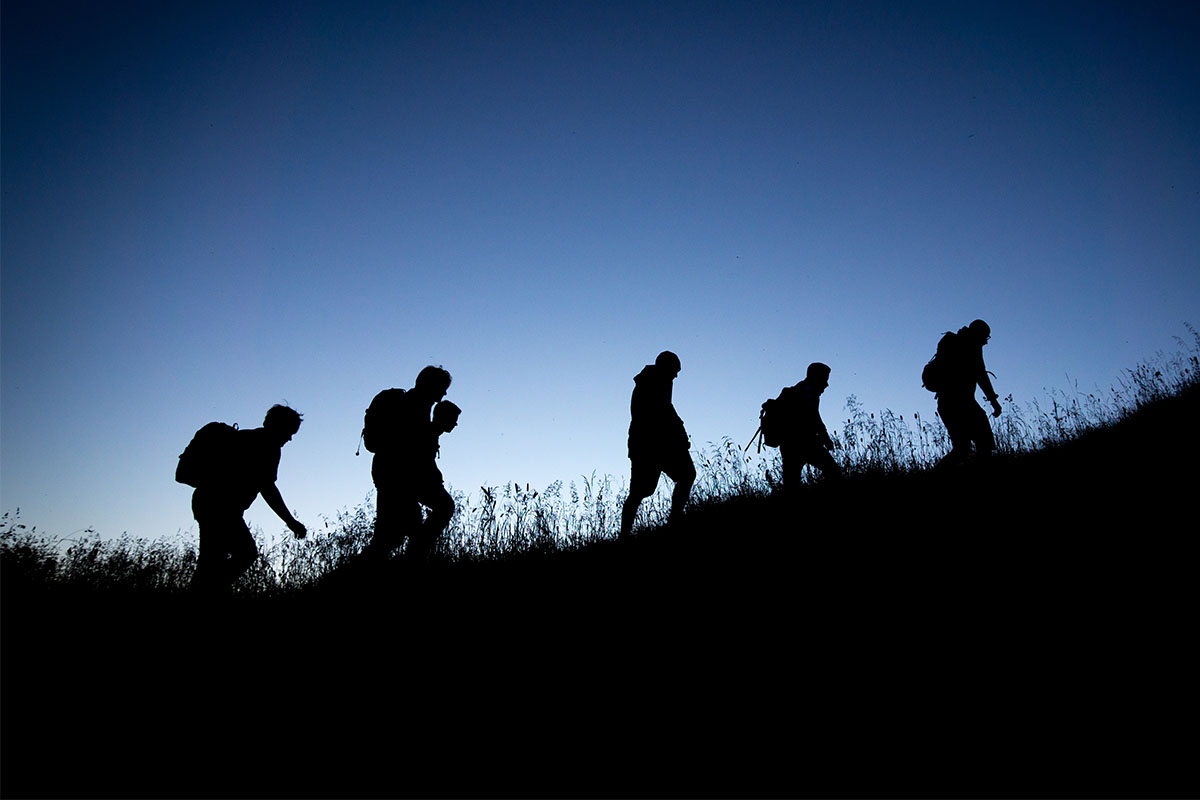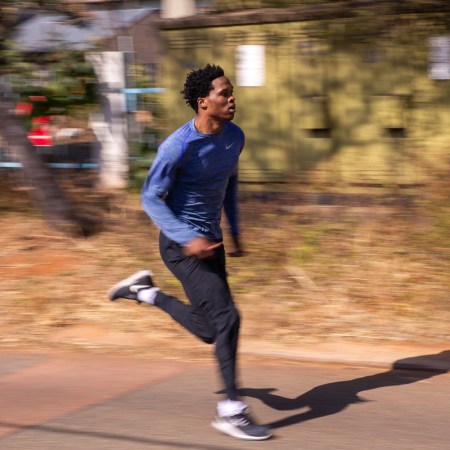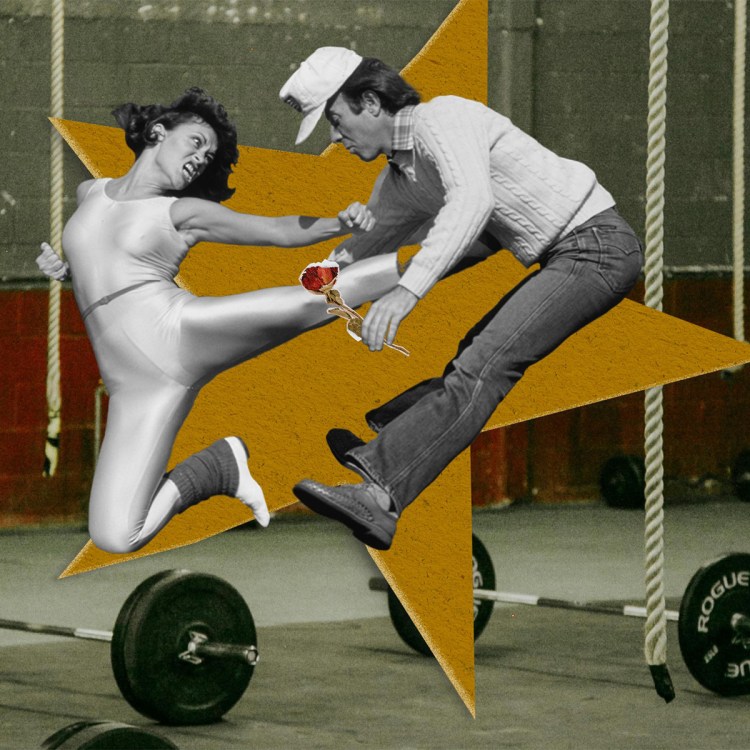Like most special ops initiations, the test to join Norway’s Long Range Reconnaissance Squadron (often referred to as the Arctic’s most elite task force) ends with a diabolical, weighted treadmill hike. Prospective soldiers must march for at least 25 straight minutes at a pace of four miles-per-hour, carrying a 55-pound pack on their backs and an eight-pound gun in their arms. Every five minutes after the 10-minute mark, an attending office raises the incline by 3%.
Last year, Norwegian climber and all-around badass Magnus Midtbø attempted the hike. He lasted 15 minutes before he had to start running to avoid getting booted off the back of treadmill. He ended up in a puddle on the ground a few minutes later, not even close to the 25-minute standard.
While these tests add to the lore of special ops training, they’re more than just a David Goggins wet dream. The weighted treadmill hike, in particular, simulates the rigors of covert missions behind enemy lines, where speed is necessary and elevation change is inevitable. Special ops squadrons prize an uncommon ratio of strength and endurance — that balance is why you’re unlikely to find a soldier worth his salt who’s either jacked like a bodybuilder or trim like a marathoner.
Carrying, better known these days by the term “rucking,” is the foundational training method of military fitness. In recent years, anthropologist adventurers like Michael Easter (author of The Comfort Crisis) have anointed rucking as an effective exercise option for those outside the armed forces, too. The pitch: while much attention has been paid to the hunting portion of “hunter-gatherer,” (Harvard’s evolutionary biologists love writing about running) what of all the gathering? Surely our ancestors had to lug their berry collections and gazelle carcasses back to basecamp?
Of course they did, and that way of life lent itself to a pretty efficient human form. Easter sums up the concept nicely: “Early humans weren’t strong like today’s gym rats — back then, having extra weight, even in the form of muscle, was a liability.” While many of today’s fitness influencers obsesses over ancestral habits to the point of fetishization, rucking is something we all should entertain.
At the very least, it’s movement — and movement of the sort that’s been known to push back our scapula, straighten our spines, strengthen the shoulders and eradicate pain in the lower back (an ailment that 80% of Americans will experience at some point in their lives, thanks to work-cycles built around screens). For those specifically looking to make performance gains, rucking is an uncommon tool in the exercise shed. According to recent research, it’s capable of burning more fat than running, and that cutting doesn’t come at the cost of muscle loss. Ruckers actually tend to gain muscle on walks, while simultaneously burning an unholy amount of calories, upping their VO2 max and reducing their cholesterol counts.
Another snippet from Easter: “[A friend of mine] described rucking as, ‘cardio for people who hate to run, and lifting for people who hate the gym.’ It corrects for body type. If you’re too big, it’ll lean you out. Too skinny? It’ll add muscle to your frame.”
Rucking’s origins might appear pretty intimidating, as a pastime practiced by ancient Homo sapiens and modern Navy SEALs. But ultimately, lugging something from one place to another is the most natural thing a human being could do; and finding ways to incorporate it into your fitness routine could give you an enviable combination of raw power and cardiovascular function.
There isn’t really a wrong way to ruck. You just need a supportive backpack and reliable walking shoes with a wide base. While a massive component of backpacking is keeping the rucksack as lightweight and economical as possible (because there’s a decent shot you’ll be walking and camping for days), rucking is a purposeful, short-term workout. You want to load your pack with weight — 25 pounds is a great place to start — and knock out a course of two miles or more, with heavy hills if you can get them.
Obviously, spring and summer are ideal times to drive out to a trail for this sort of effort. You can find some excellent local options at AllTrails. But I’m a staunch supporter of indoor rucking, too, in the vein of those special ops weighted treadmill hikes. It’s a great way to find your baseline “rucking shape.” It’ll give your body the crash course it needs before braving wilderness and terrain, while helping to establish a rhythm; assuming you have access to a treadmill at the gym, you can ruck multiple times a week, modulating the workout here and there as you see fit.
Here’s one of my favorite workouts, ripped from a seven-year-old message board where a bunch of hardcore ruckers like to trade notes about their favorite activity:
- 20-minute workout
- Set the treadmill to four miles per hour
- Start at a 0% grade
- Each minute, add 1% of incline
- After the minute at 10% grade, start working back down
- Finish the final minute at 0% grade
- You should stay at four miles per hour the entire time
I absolutely love this workout. Written down like that it appears somewhat manageable, but it’s a scorcher, and typically leaves me drenched in sweat. Beware, the treadmill speed is no joke. Four miles per hour is equivalent to a 15:00 mile pace, which is an awkward in-between where you feel like you should be running. You’re speed-walking, basically, and slipping off the edge of the treadmill is always in the back of your mind. It keeps you locked in to your internal motor. (Incidentally, a 15:00 mile pace is considered the military gold standard.)
When I first read the workout I didn’t know what to think of the ladder construction; how could it be, if the entire back half gets easier and easier? But it’s not like you’re going downhill. The 8% incline, for instance, hurts just as much the second time through. By the time the elevation gets down to 3% and below it’s a welcome reprieve, but you’re still desperate to rip the pack from your back.
All told, rucking is as full-body an exercise as anything I’ve brought into my personal training. For one, your upper half is on fire. (Pro tip: if you don’t have access to rectangular plates, and are stuffing a dumbbell or kettlebell in your pack, perch it atop some sweatshirts, in order to keep it as high on the spine as possible. This will help with your posture.) But so are your legs, for reasons that don’t need to be explained, and in order to keep them headed on parallel tracks, instead of stumbling around the rubber, your core needs to be flying on all cylinders, too.
That’s without even mentioning the brain, which needs to eschew reason for a little bit and go to a dark place in order to get you through the workout. Granted: this workout is more fun and more beautiful outside, as opposed to the basement gym where I tend to knock it out. If you’re sufficiently motivated to get out and ruck like your hairiest ancestor, be my guest. But for those looking to get their feet wet and their shoulders stronger, going Zero Dark Thirty on a treadmill is a great way to start.
The Charge will help you move better, think clearer and stay in the game longer. Subscribe to our wellness newsletter today.

























